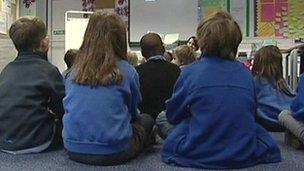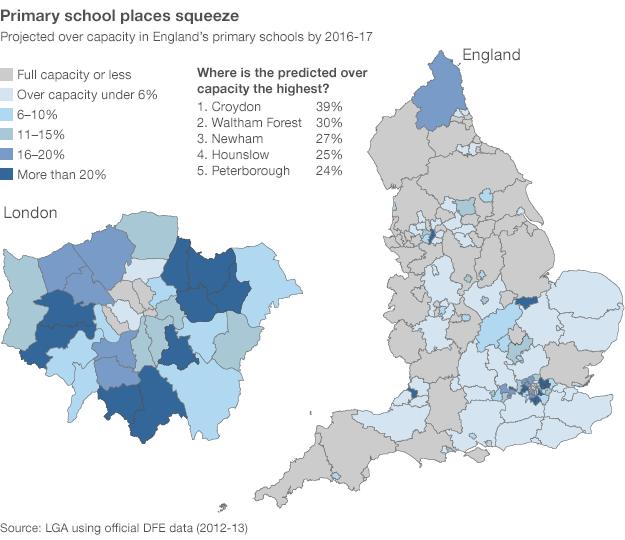Half of school districts face places crunch
- Published

Local councils say their hands have been tied over school places
Almost half of England's school districts will have more primary pupils than places within two years, the Local Government Association (LGA) has said.
Some local areas will face a 20% shortfall in places by 2015, according to analysis of official data from 2012.
Rising birth rates began the squeeze but uncertainty over funds has made it worse, the LGA says.
The government says it has more than doubled funding for new school places.
Councillor David Simmonds, LGA: "Mums and dads want to know that there's a good quality school in their neighbourhood"
The LGA's warning comes as the government opens 93 free schools - 46 with primary places - raising the total to 174 and providing 43,000 new school places.
Free schools and academies are approved directly by the Department for Education, and councils say this can limit their ability to plan strategically, especially as they have no powers to force such schools to expand or close in response to changes in demand.
The LGA wants a ban on any new free schools opening where there is a surplus of places.
Most of the free schools opening this year are in areas under pressure, but not necessarily those under the most pressure.
And five are in areas forecast to have surplus primary places within two years.
The government said 70% of free schools were in areas with a basic need - under pressure. But councils say it is the longer term picture that is important because they have to plan ahead for population growth.
'Desperate shortage'
The LGA's analysis of local authority data on school-place needs suggests about 1,000 of the 2,277 local school planning districts will be over capacity by 2015-16.
The greatest pressure is focused on about 99 districts, where 20% more pupils are predicted than places.
However, the findings do not take into account some recent steps to increase school places because the analysis is based on official figures from the last academic year.
Councils have always used predictions of need to make school-building and expansion plans.
Overall, two thirds of local authorities predict they will have more pupils than places by the beginning of the 2016 academic year.
Some 40 local councils are predicted to be 10% over capacity, with 15 of those predicting a 20% surplus of pupils over places.
Peterborough, Redbridge, Ealing, Bristol, Lewisham, Slough, Maidenhead, Sutton, and Barking and Dagenham will have to increase the number of school places by at least 20% to ensure every child gets a place, the LGA said.

LGA education chairman David Simmonds said councils were facing "unprecedented pressures" in tackling the "desperate shortage" of new school places.
Some schools have already converted music rooms, libraries - even a police station in one case - into classrooms.
'Shovels and diggers'
The LGA is calling for the DfE to work more closely with local councils, so planning for emerging demand can be better managed.
Mr Simmonds said free schools were a "small part of the overall picture", but parents in hard-pressed areas would understandably ask why money was being spent on extra free school places in areas where there were already vacancies.
He said the key thing was to ensure that £5bn recently made available by the government to boost capacity was spent quickly and efficiently in the areas where it was most needed.
"We need to make sure that money comes through the local authority who are often ready with their shovels and diggers to get work under way immediately."
The LGA also says the fact that the DfE has used four different methods for funding school places since 2007 has led to a piecemeal approach - and all the money should, in future, come from a single pot.
'Swift action'
The government and Labour blamed each other for the situation.
Education Secretary Michael Gove said the coalition had "taken swift action to repair the damage" left by Labour, accusing Ed Miliband of being "too weak to stand up to the unions and back free schools".
Education Secretary Michael Gove says Labour ignored warnings on school capacity while in power
"We have more than doubled funding for new school places and we are also setting up great new free schools, which are giving parents a choice of high quality school places in areas Labour neglected," he said.
But shadow education secretary Stephen Twigg said: "More than three years into his government, David Cameron must face up to the primary school places crisis of his own making."
He added that in choosing to prioritise school capital funding in areas with surplus places through his free schools programme, the prime minister was failing to meet basic need for school places.
The New Schools Network, which helps groups set up their own schools, said free schools were on track to deliver more than 250,000 new places by 2015.
But National Union of Teachers leader Christine Blower says free schools are an entirely unnecessary expense at a time when there is a chronic shortage of school places around parts of the country because many are being opened where there is already a surplus of school places.
- Published3 September 2013
- Published24 July 2013
- Published15 March 2013